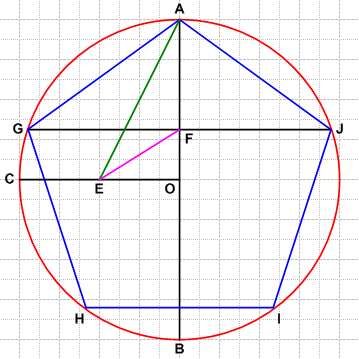Pentagon
In geometry, a pentagon is a polygon with 5 sides. The sum of the internal angles of any pentagon is ![]() . Each angle of a regular pentagon is
. Each angle of a regular pentagon is ![]() .
.
Construction
It is possible to construct a regular pentagon with compass and straightedge:
- Draw circle
 (red).
(red). - Draw diameter
 and construct a perpendicular radius through
and construct a perpendicular radius through  .
. - Construct the midpoint of
 , and label it
, and label it  .
. - Draw
 (green).
(green). - Construct the angle bisector of
 , and label its intersection with
, and label its intersection with  as
as  (pink).
(pink). - Construct a perpendicular to
 at
at  .
. - Adjust your compass to length
 , and mark off points
, and mark off points  ,
,  and
and  on circle
on circle  .
.  is a regular pentagon.
is a regular pentagon.
The Golden Ratio and the Pentagram
The regular pentagon is closely associated with the Golden Ratio. More specifically, the ratio of a diagonal to an edge is ![]() .
By drawing each of the diagonals, one can form a pentagram, or five-pointed star, in which each of the internal angles is
.
By drawing each of the diagonals, one can form a pentagram, or five-pointed star, in which each of the internal angles is ![]() .
.
See Also
This article is a stub. Help us out by expanding it.










